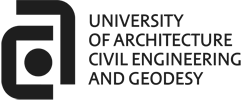Students acquire knowledge on the displacement method for analysis of frames and beams. Skills are gained for computation of buckling loads in beams and frames, and basic notions are obtained for the dynamics of structures - dynamic loads, free and forced vibrations of single degree of freedom- and multi degree of freedom systems; modal analysis; seismic excitations; determination of seismic loads through modal analysis, response spectrum method, and according to the seismic building codes. Students are being acquainted also with methods for analysis of axial-symmetrically loaded shell structures - tanks.
„Structural Mechanics" is a subject for the students studying in the specialty “Water Supply and Sewerage”. Together with its first part it consists:
- Structural statics analysis of statically determinate and statically indeterminate frame structures (beams, frames, trusses);
- Introduction in stability of frame systems;
- Dynamics of frame structures (short course);
- Some concepts from the theory of elasticity - plates, shells.
The structural mechanics creates a very necessary connection between the general theoretical disciplines (Mathematics, Physics, Theoretical mechanics, Strength of materials) and special constructive subjects (Reinforced concrete structures, Steel structures, Hydraulic Structures).
It provides for information on special features for civil engineer (regardless of his specialty) with the modern methods of strength, stability and dynamic study of the engineering facilities subjected to various impacts – static and dynamic external forces and loads, temperature changes, bearing movements, earthquakes, etc.
Acquired knowledge Diagrams of internal forces in frames. Eigen frequency and period of a simple (SDOF) structure. Eigen frequencies and modes. Response curves. Critical load. Internal forces and boundary conditions in rectangular and circular plates, cylindrical storage tanks (as a system of circular plates and cylindrical shells).
Acquired skills Analysis, design and evaluation of statically indeterminate structures subjected to different types of loadings- static load, temperature load and support settlement. Evaluation of critical load and its corresponding equilibrium shape. Calculating the internal forces from dynamic loading: harmonic force or seismic input-response spectrum curve. Applying a seismic analysis procedures according code for design. Using a FEM with software for structural design.
Preliminary requirements: Reduction of a set of forces. Moment of a force about a point/an axis. Magnitude of the resultant force of distributed load. Support reactions in simple structures. Center of gravity of bodies, areas. Inertial characteristics of cross section. Principal moments and principal axes of inertia. Internal forces diagrams in statically determinate structures. Dynamics of rigid body. Ordinary and partial differential equations, linear algebra.

